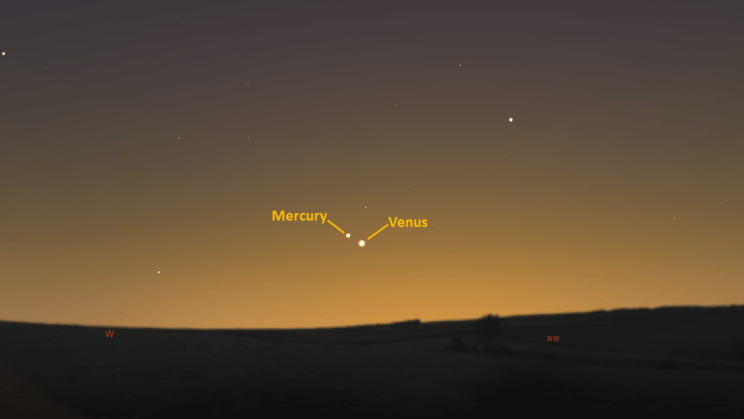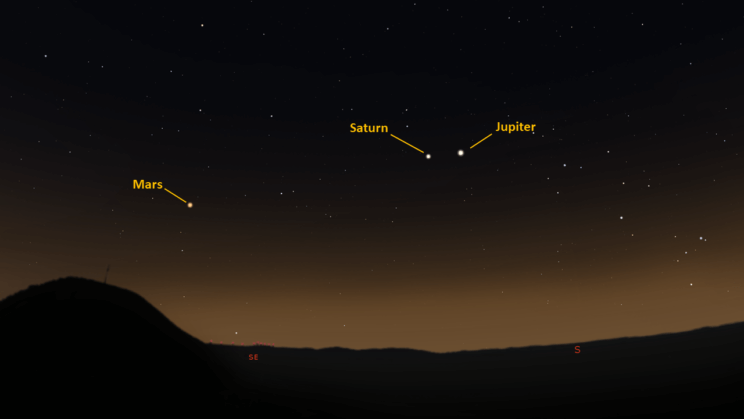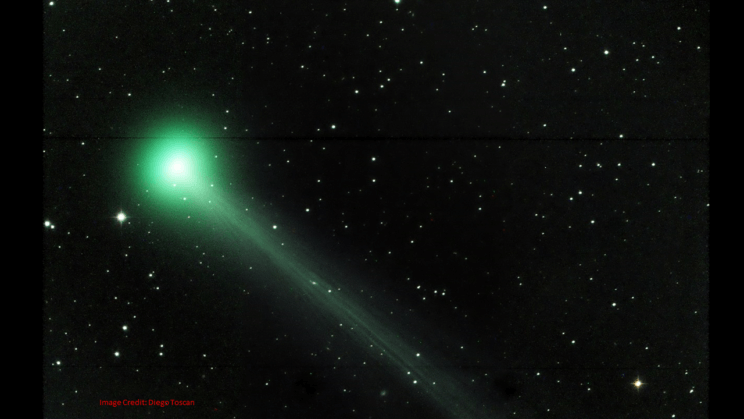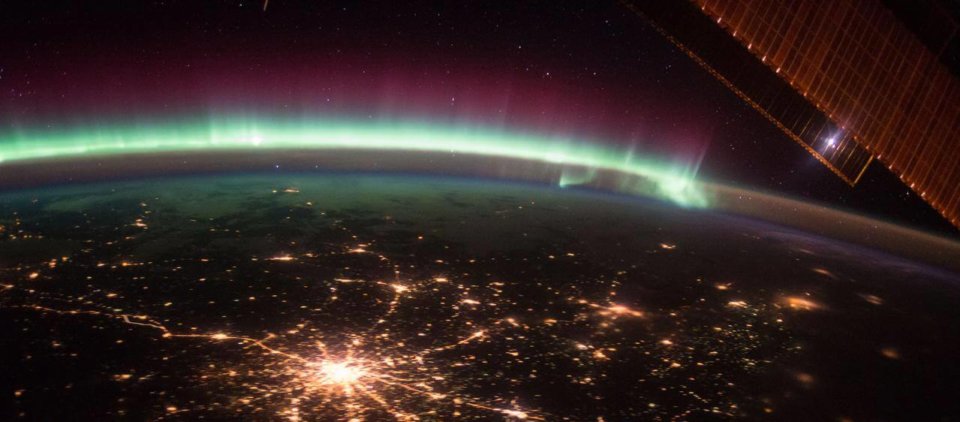This is the Saint Louis Science Center’s NIGHT SKY UPDATE for the week of Friday, May 22, 2020.
Information updated weekly or as needed.
Times given as local St. Louis time (CDT). For definitions of terminology used in the night sky update, click the highlighted text.
For now, star parties at the Saint Louis Science Center have been canceled due to recommendations from the CDC regarding COVID-19. All public telescope events are canceled until further notice. As conditions change, we will reevaluate and update this article once public observing events resume.
The Sun and Moon

The Moon as seen from the International Space Station, on July 31, 2011.
Credit: NASA
Sunrise is at 5:43 a.m. on Friday, May 22 and sunset is at 8:13 p.m. providing us with about 14.5 hours of daylight. Even after sunset, the light from the Sun will dimly illuminate our sky for almost 2 hours. This period is called twilight, which ends around 10:03 p.m. this week. For those with a sundial, solar transit or local noon occurs around 12:58 p.m. this week.
| Day | Sunrise | Sunset |
|---|---|---|
| 2020-05-22 | 5:43 a.m. | 8:13 p.m. |
| 2020-05-23 | 5:43 a.m. | 8:14 p.m. |
| 2020-05-24 | 5:42 a.m. | 8:14 p.m. |
| 2020-05-25 | 5:42 a.m. | 8:15 p.m. |
| 2020-05-26 | 5:41 a.m. | 8:16 p.m. |
| 2020-05-27 | 5:40 a.m. | 8:17 p.m. |
| 2020-05-28 | 5:40 a.m. | 8:17 p.m. |
| 2020-05-29 | 5:39 a.m. | 8:18 p.m. |
| 2020-05-30 | 5:39 a.m. | 8:19 p.m. |
Moonrise for Friday, May 22 occurs at 5:50 a.m. and moonset will occur at 8:19 p.m. On Friday, May 22 the Moon will reach new moon at 12:39 p.m. First quarter moon occurs on May 29.
International Space Station (ISS) Observing

Visible passes of ISS from St. Louis for the week of May 22 occur during evening hours. The best of these occurs on the evening of May 30. Use the table below for information about these and other visible passes of ISS.
Catch ISS from St. Louis starting Friday, May 22
| Date | Starts | Max. altitude | Ends | |||||||
|---|---|---|---|---|---|---|---|---|---|---|
| Time | Alt. | Az. | Time | Alt. | Az. | Time | Alt. | Az. | ||
| 22 May | -0.8 | 20:41:17 | 10 | WNW | 20:43:31 | 16 | NNW | 20:45:45 | 10 | NNE |
| 22 May | -0.7 | 23:57:23 | 10 | NNW | 23:59:02 | 15 | N | 23:59:02 | 15 | N |
| 24 May | -0.9 | 23:57:59 | 10 | NNW | 23:59:15 | 18 | NNW | 23:59:15 | 18 | NNW |
| 25 May | -1.4 | 23:10:24 | 10 | NNW | 23:12:57 | 19 | NNE | 23:12:58 | 19 | NNE |
| 26 May | -1.0 | 22:22:52 | 10 | NNW | 22:24:53 | 15 | NNE | 22:26:40 | 11 | NE |
| 26 May | -0.8 | 23:58:48 | 10 | NW | 23:59:35 | 16 | NW | 23:59:35 | 16 | NW |
| 27 May | -2.0 | 23:11:03 | 10 | NW | 23:13:20 | 32 | N | 23:13:20 | 32 | N |
| 28 May | -2.1 | 22:23:23 | 10 | NNW | 22:26:18 | 26 | NNE | 22:27:05 | 24 | NE |
| 29 May | -1.5 | 21:35:45 | 10 | NNW | 21:38:16 | 19 | NNE | 21:40:46 | 10 | ENE |
| 29 May | -1.9 | 23:11:59 | 10 | NW | 23:13:47 | 29 | WNW | 23:13:47 | 29 | WNW |
| 30 May | -3.7 | 22:24:06 | 10 | NW | 22:27:27 | 67 | NE | 22:27:37 | 66 | ENE |
Magnitude (Mag): The Measure of brightness for a celestial object. The lower the value is, the brighter the object will be.
Altitude (Alt): The angle of a celestial object measured upwards from the observer’s horizon.
Azimuth (Az): The direction of a celestial object, measured clockwise from an observer’s location with north being 0°, east being 90°, south being 180° and west being 270°.
For information about ISS flyovers and other visible satellites, visit www.heavens-above.com
Detailed information regarding all unmanned exploration of our universe, missions past, present, and planned, can be found at Jet Propulsion Laboratories:
The Visible Planets

Looking West, 30 Minutes After Sunset, May 22, 2020
Credit: Stellarium, EG

Looking Southeast, 4:00 am, May 23, 2020
Credit: Stellarium, EG
This week, five naked eye planets are visible. Mercury and Venus will be visible in the west after sunset. Mars, Jupiter and Saturn are visible in the south and southeast in the morning hours.
For those tracking Jupiter and Saturn as they approach their great conjunction later this year, the two gas giants currently appear just over 4° apart in the sky. If you keep watching them as 2020 progresses, you will see some interesting behaviors that inspired early astronomers to track the skies.
Mercury and Venus will be in conjunction on Friday, May 22. Unfortunately, true conjunction occurs after the planets set. From St. Louis we will see the pair a little over 1° apart, roughly 30 minutes after sunset.
Mercury
Mercury has started another evening apparition. You can look for Mercury about 40 minutes after sunset in the west. Greatest elongation occurs on June 4. As we lose Venus, we will see Mercury climb higher in the sky. Mercury will set around 9:46 p.m.
Venus
The brightest planet in the sky is visible in the west as the sun sets. Venus is reaching the end of another evening apparition as it approaches inferior conjunction on June 3, 2020. Venus will set around 9:42 p.m. Currently, Venus is exhibiting a crescent phase with only 4.8% of the Venus disk illuminated. Take care and make sure the Sun has set before observing Venus. Each day Venus gets closer to the Sun in the sky.
Mars
The red planet rises around 2:10 a.m. and will be high enough to see in the southeast by 3:10 a.m. Opposition for Mars occurs on October 13, 2020. As we head towards this date Mars will appear brighter and its surface will eventually be visible through a telescope.
Jupiter
The king of the planets is rising around 12:07 a.m. and should be visible in the southeast around 1:00 a.m. Each week you will find Jupiter rising about 20 minutes earlier than it did in the previous week.
Saturn
Saturn is rising around 00:23 a.m. Like Jupiter you will need a clear sky to the southeast to catch the ring planet around 1:30 a.m. Later this year Jupiter and Saturn will reach conjunction on December 21, 2020. You can track these planets as they appear to chase one another throughout the rest of this year.
2020 Great Conjunction
This year, the planets Jupiter and Saturn will reach conjunction. A conjunction is when two or more celestial bodies share the same right ascension. For Jupiter and Saturn, this astronomical event only occurs every 20 years. The conjunction will occur on December 21, 2020. You will find the two planets close together in the southwestern sky just after sunset on this date.
Comet Watch

Comet C/2020 F8 SWAN
Credit: Diego Toscan
Comet SWAN (C/2020 F8)
Comet C/2020 F8 SWAN was discovered by Michael Mattiazzo searching imagery from the Solar Wind Anisotropies (SWAN) camera on the Solar and Heliospheric Observatory (SOHO). SWAN’s primary science objective has to do with monitoring the solar wind in Lyman-α light, a type of UV radiation. It also monitors sunspots and can observe comets in this same emitted wavelength of light. Learn more at https://sohowww.nascom.nasa.gov/about/instruments.html
Comet Swan has passed Earth and is now headed towards its perihelion on May 27, 2020. It has likely peaked in magnitude reaching roughly 5th magnitude. Comets often will suddenly brighten due to out gassing events, but it is likely the best views are over.
Currently Comet SWAN is around 6.7 magnitude. There are several ways to track this comet. The two I regularly use are Stellarium and www.heavens-above.com. Both will require minor set up, but they are easy to use.
Visit the James S. McDonnell Planetarium for more information on what’s up!
Night Sky Update: May 22-May 30, 2020






